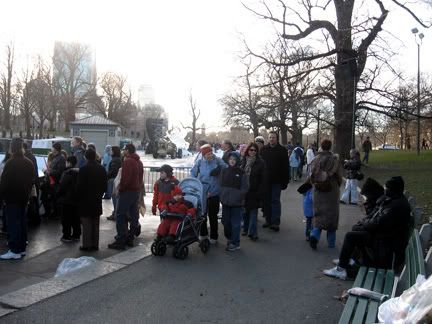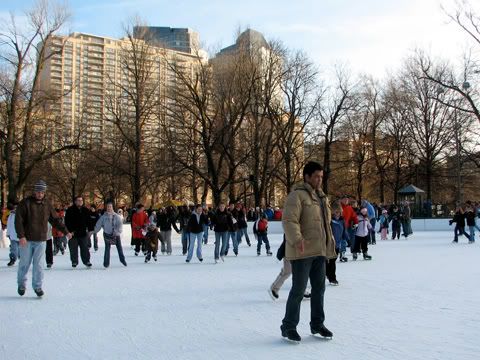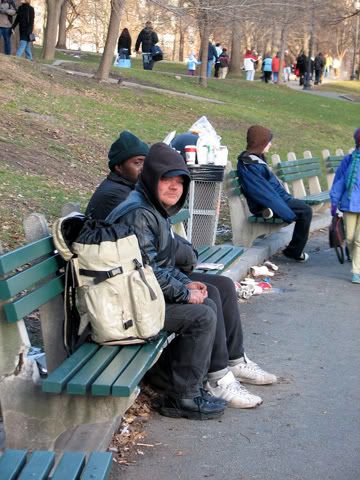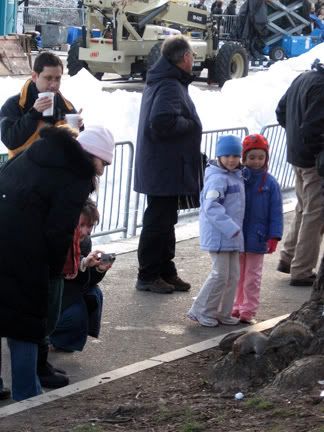365 Urban species. #365: Human

Photo by urbpan. Location: Boston Common.
Urban species #365: Human Homo sapiens
Of the seven species of great apes, six are endangered and restricted to tiny disjointed islands of tropical habitat. The seventh has spread to every continent and island on earth, numbers more than six billion individuals, and is the builder of cities. Humans are at once, merely animals, and the most unusual and important animals to have evolved. Humans are fairly fragile creatures, tolerant of a narrow range of temperatures, mostly dull in senses, and without any kind of physical weaponry to defend themselves. Yet they have domesticated hundreds of other species, driven hundreds of others to extinction, and have constructed elaborate technologies which allow them to live anywhere, and have even created vehicles that have left the atmosphere of the planet and returned with human crews unharmed.
Perhaps the greatest ability of the human species is its ability to communicate and store information. By creating systems to archive information, the accumulated ingenuity of the species grows nearly exponentially. Other animals (chiefly other apes) may learn a skill, such as fishing for termites or cracking nuts, and pass it to another generation. But should those individuals die, their information dies with them. Humans have developed the ability to collect information, save it, and then build upon what is already known. The ability to imagine information in symbolic form, as impressions in clay, marks on paper, or blinking lights on a screen, has trumped all other adaptations in nature.
Humans have altered the ability of the planet to sustain life. Like all living things, they act only in self-interest. Unfortunately, possessing technologies that have effects far beyond their intended purpose, acting on that self-interest has not always been positive for other life forms. The spread of humans from Africa and Asia into other places was followed by a cascade of extinctions, most of which are lost to prehistory. The development of agriculture meant clearing vast amounts of wilderness to favor small numbers of chosen animal and plant species. The subsequent creation of cities led to a further narrowing of the diversity of wildlife interacting with humans. Technologies developed in the past hundred and fifty years are inadvertently affecting the climate of the entire planet. A species that has existed for less than one half of a thousandth of a percent of the existence of earth is currently changing the future of that planet for all other species. Many species will go extinct, others will thrive; this has always been the effect of humans on other species.
Though humans have created the ecology of the city, they do not generally participate in it. The overwhelming majority of humans will never eat any animal or plant that has lived its whole life in a city. (An urban gardening and agriculture movement is growing in some cities. And there are those urban foragers who angle for fish, or collect raspberries, ginkgo nuts, or mushrooms, but they are fringe exceptions.) Urban humans consume food that has been grown outside of the city on farms, or increasingly, on huge industrial agricultural facilities. Energy from outside of the city is processed within it, and the waste materials are dealt with in urban waterways, or otherwise exported. Urban humans generally do not see the living things in the city as a potential food source. Partly this is because the city is associated with pollution and contamination, and urban organisms are popularly viewed as tainted. This view is best illustrated by the pigeon, a plump bird raised for food in ancient cities, now so fully associated with modern cities that the idea of eating it inspires visceral disgust in most people. The city is where human artifice is supposed to rule--any "nature" occurring there is seen as an aberration, a scavenger, a parasite, unclean.
Many humans believe that the modern city is a construct that exists outside of nature. Of course, this isn't true, or even possible, and living things and other natural processes occur everywhere. Life simply accepts the new conditions that humans have imposed and works within those limitations. Even the vessels in orbit around the planet are filled with mold, and contain hitchhiking mosquitoes. Cities are filled with the life forms that were either forcibly brought to them, such as house sparrows and starlings, or came along on human vessels, like cockroaches and mice, or were predisposed to urban conditions, like squirrels and robins. Humans chose the life forms that live with them in the city, whether they meant to or not.
Though humans deliberately created cities as refuges of artifice, safe from beasts and weather, they seek out the solace of nature. All cities have parks and open spaces, places where valuable real estate has been set aside as habitat, or at least the illusion of habitat. The need to experience living things is strong enough so that humans have conceived of complex and everchanging ethics about nature and the environment. Sometimes adherents to different ethical systems are in conflict: "animal lovers" decry the destruction of Canada geese while "ecologists" call the destruction necessary. All agree to feeling some joy being surrounded by living things; the need to seek out nature in the city is powerful and widespread.
Humans have always sought out ways to connect themselves to a larger whole. The negative effects that humans have on the rest of the living things of the world disappoints and saddens us. We, us humans, the only animals that can write and communicate with others of our species, across the barriers of time and distance, are looking for ways to make things better. About half of the human population lives in cities, a percentage that is expected to increase. The human connection with nature, for most of us, for the future, will start in the city. Our feelings about the universe will start with interactions with animals and plants and other living things that we encounter in the urban ecosystem. The path to making things better, is understanding and appreciating those living things, and what actions of ours brought them to coexist with us, and communicating those appreciations and discoveries with others.
Humans are the only species in the history of life on earth that have the ability to consciously shape the future. The ecosystems that continue to exist, the living things that do not become extinct, and the way that the world will look, are entirely within the power of one species of ape.


Photos by cottonmanifesto.

A group of humans are delighted by a gray squirrel. Photo by urbpan.